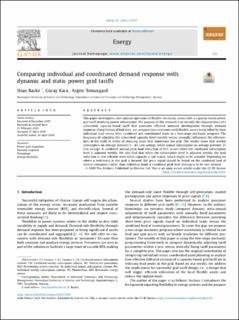| dc.contributor.author | Backe, Stian | |
| dc.contributor.author | Kara, Güray | |
| dc.contributor.author | Tomasgard, Asgeir | |
| dc.date.accessioned | 2020-08-25T08:03:47Z | |
| dc.date.available | 2020-08-25T08:03:47Z | |
| dc.date.created | 2020-05-05T10:56:40Z | |
| dc.date.issued | 2020 | |
| dc.identifier.citation | Energy. 2020, 201 1-11. | en_US |
| dc.identifier.issn | 0360-5442 | |
| dc.identifier.uri | https://hdl.handle.net/11250/2673796 | |
| dc.description.abstract | This paper investigates cost-optimal operation of flexible electricity assets with a capacity-based power grid tariff involving power subscription. The purpose of this research is to identify the characteristics of a subscribed capacity-based tariff that promotes efficient network development through demand response. Using historical load data, we compare two consumers with flexible assets being billed by their individual load versus their combined and coordinated loads in a two-stage stochastic program. The frequency of adjusting the subscribed capacity level (weekly versus annually) influences the effectiveness of the tariff in terms of reducing loads that dimension the grid. The results show that weekly subscription on average provides cost savings, while annual subscription on average provides 3% cost savings. A combined annual peak load reduction of occurs when the combined subscription level is adjusted weekly. We also find that when the subscription level is adjusted weekly, the load reduction is cost efficient even when capacity is not scarce, which ought to be avoided. Depending on where a bottleneck in the grid is located, the price signal should be based on the combined load of several consumers rather than individual loads if combined peak load shaving is to be cost-optimal. | en_US |
| dc.language.iso | eng | en_US |
| dc.publisher | Elsevier | en_US |
| dc.relation.uri | https://doi.org/10.1016/j.energy.2020.117619 | |
| dc.rights | Navngivelse 4.0 Internasjonal | * |
| dc.rights.uri | http://creativecommons.org/licenses/by/4.0/deed.no | * |
| dc.title | Comparing individual and coordinated demand response with dynamic and static power grid tariffs | en_US |
| dc.type | Peer reviewed | en_US |
| dc.type | Journal article | en_US |
| dc.description.version | publishedVersion | en_US |
| dc.source.pagenumber | 1-11 | en_US |
| dc.source.volume | 201 | en_US |
| dc.source.journal | Energy | en_US |
| dc.identifier.doi | 10.1016/j.energy.2020.117619 | |
| dc.identifier.cristin | 1809419 | |
| dc.relation.project | Norges forskningsråd: 257626 | en_US |
| dc.relation.project | Norges forskningsråd: 257660 | en_US |
| dc.description.localcode | This is an open access article distributed under the terms of the Creative Commons CC-BY license, which permits unrestricted use, distribution, and reproduction in any medium, provided the original work is properly cited. | en_US |
| cristin.ispublished | true | |
| cristin.fulltext | original | |
| cristin.qualitycode | 2 | |

